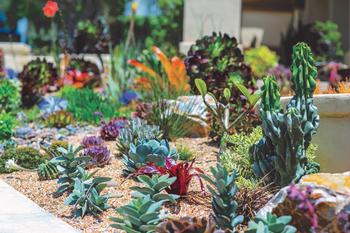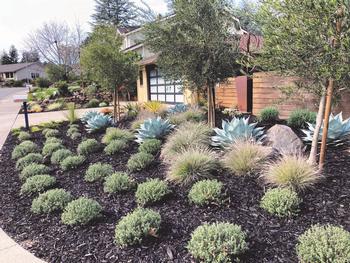Water worries!
-
Wendy Irving
-
Now is the time to think about preparing your garden for the upcoming dry season, although it seems like we are there already. According to Marin Water, rainfall and runoff are at historical lows and, barring some miraculous spring storms, local water districts will be taking actions similar to those of past droughts. On February 16, the Marin Water Board made an official declaration of drought, calling for a voluntary reduction in water usage. On April 1, if water availability is less than 40,000 acre feet, mandatory and stricter guidelines will come into play requiring additional reductions in water usage. The North Marin Water District is looking to announce water usage reduction April 1, but has been encouraging conservation, announcing in January that it is a dry year and outlining conservation messages through their website and social media.
 Succulents are a great replacement for lawn, needing little water and maintenance. Photo: Salvador Ceja/Dreamstime
Succulents are a great replacement for lawn, needing little water and maintenance. Photo: Salvador Ceja/DreamstimeUC Marin Master Gardeners (MMGs) offers a free program to help Marin residents plan for and manage water consumption in the garden. Marin Friendly Garden Walks is a partnership between MMG’s and Marin Water, providing homeowners in Marin with information/advice on improving their irrigation practices to conserve precious water resources (Garden Walks are also offered in areas in Marin outside Marin Water). Garden Walks had been suspended due to the current pandemic, but are scheduled to resume this month, weather permitting and following appropriate virus safety measures. Please check out the MMG website at marinmg.ucanr.edu and click on the Help link and then the Garden Walks tab. From there, you can fill out an online request for a Garden Walk at your home or email your request for more information and scheduling to HelpDesk@marinmg.org.
It’s a good idea to figure out how much water you generally devote to your garden during the dry season so you can manage any reductions. Typically, gardeners operate irrigation systems between May and October. Try reviewing your water bills for the last few years and see how many gallons per day you average during the winter when you are not irrigating. Compare this number to your past usage in the summer months and you’ll get an idea of how much water you use to irrigate (if you have a swimming pool, take this into consideration). Learn to read your water meter (a MMG Garden Walk you help you do this). Creative use of a variety of water-wise plants and hardscape materials can make an attractive alternative to your front lawn. Photo: Wendy Irving
Creative use of a variety of water-wise plants and hardscape materials can make an attractive alternative to your front lawn. Photo: Wendy IrvingIn the meantime, make sure your current irrigation system is in good repair and has no run-off. Start replacing overhead sprinklers with drip irrigation where appropriate. If you haven’t yet replaced your lawn completely, or at least decreased its size to the space you and your kids and pets typically use, think about doing it now. Lawns account for the majority of water used in residential irrigation. There are many drought tolerant plants and low growing ground covers which, combined with creative applications of hardscapes such as decks, walkways, mulches and stones, make for an attractive water-wise garden. Both Marin water districts have rebate programs to help you.
Which plants in your landscape are most important to you? In drought years, you have to prioritize. Fruit trees, landscape trees and large shrubs are harder to replace than perennials, ground covers and annuals. If you like a vegetable garden, prioritize that, too, but size it right for your family needs, use a drip system, mulch and compost well, keep the weeds down, and know the critical times for correct watering of the vegetables you choose.
Some general water saving tips for the garden – water early in the morning, reducing water loss from evaporation and wind. Group plants with similar water needs. Water more deeply and less frequently, and adjust the irrigation schedule seasonally. Don’t encourage too much new growth by over fertilizing, and don’t over prune. Be generous with mulch, applying three to four inches to reduce evaporation, heat and weeds. Select plants that are drought resistant, but plant them in the fall so they can become established during the next (hopefully) rainy season!


